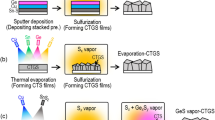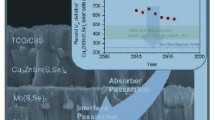Abstract
Solution-processed CuInGaS2 (CIGS) thin-film solar cells are promising for large-scale commercialization due to their economic process although the efficiency still needs to be improved to compete with vacuum-based materials. Systematic studies were performed to optimize the series and shunt resistance of hydrazine-based CIGS solar cells. Optimization was achieved through compositional adjustment of copper (Cu) near the p-n junction and gallium (Ga) near the back contact. Cu adjustments optimized the shunt resistance between 4000 and 5000 Ω cm2. Ga adjustments optimized the series resistance to 2 Ω cm2. Shunt and series resistance play vital roles in the fill factor. Fill factor was hence improved upward of 0.80 with the optimization of Cu and Ga. Chemical etching was also conducted to investigate the durability of the materials and to remove small crystals near the interface. Device conversion efficiencies were improved up to 12.4%. This study provides the implications for improving the device performance of chalcogenide solar cell materials.










Similar content being viewed by others
References
I. Repins, M.A. Contreras, B. Egaas, C. DeHart, J. Scharf, C.L. Perkins, B. To, and R. Noufi: 19.9%-efficient ZnO/CdS/CuInGaSe2 solar cell with 81.2% fill factor. Prog. Photovoltaics 16, 235 (2008).
M. Kaelin, D. Rudmann, and A.N. Tiwari: Low cost processing of CIGS thin film solar cells. Sol. Energy 77, 749–756 (2004).
D. Guimard, N. Bodereau, J. Kurdi, J.F. Guillemoles, D. Lincot, P-P. Grand, M. Ben Farrah, S. Taunier, O. Kerrec, and P. Mogensen: Efficient Cu(In,Ga)Se2 based solar cells prepared by electrodeposition. Mater. Res. Bull. 763, B6.9.1–B.9.6 (2003).
R.N. Bhattacharya, J.F. Hiltner, W. Batchelor, M.A. Contreras, R. Noufi, and J.R. Sites: 15.4% CuIn1-xGaxSe2-based precursor films. Thin Solid Films 361–362, 396–399 (2000).
V.K. Kapur, A. Bansal, P. Le, and O.I. Asensio: Non-vacuum processing of CuIn1-xGaxSe2 solar cells on rigid and flexible substrates using nanoparticle precursor inks. Thin Solid Films 431–432, 53–57 (2003).
C. Eberspacher, C. Fredric, K. Pauls, and J. Serra: Thin film CIS alloy PV materials fabricated using non-vacuum, particles-based techniques. Thin Solid Films 387, 18–22 (2001).
M.H-C. Jin, K.K. Banger, J.D. Harris, and A.F. Hepp: The effect of film composition on the texture and grain size of CuInS2 prepared by chemical spray pyrolysis. Mater. Res. Bull. 763, B8.23.1–B8.23.6 (2003).
W. Liu, D.B. Mitzi, M. Yuan, A.J. Kellock, S.J. Chey, and O. Gunawan: 12% efficiency CuIn(Se,S)2 photovoltaic device prepared using a hydrazine solution process. Chem. Mater. 22, 1010–1014 (2010).
T.K. Todorov, O. Gunawan, T. Gokmen, and D.B. Mitzi: Solution-processed Cu(In,Ga)(S,Se)2 absorber yielding a 15.2% efficient solar cell. Prog. Photovoltaics 21, 82–87 (2013).
D.B. Mitzi, M. Yuan, W. Liu, A.J. Kellock, S.J. Chey, V. Deline, and A.G. Schrott: A high-efficiency solution deposited thin film photovoltaic device. Adv. Mater. 20, 3657–3662 (2008).
D.B. Mitzi, M. Yuan, W. Liu, A. Kellock, S.J. Chey, A. Schrott, and V. Deline: Solution processing of CIGS absorber layers using a hydrazine-based approach. In Photovoltaics Specialist Conference, 33rd IEEE, DOI: https://doi.org/10.1109/PVSC.2008.4922730 (2008).
D.B. Mitzi, M. Yuan, W. Liu, A.J. Kellock, S.J. Chey, L. Gignac, and A.G. Schrott: Hydrazine-based deposition route for device quality CIGS films. Thin Solid Films 517, 2158–2162 (2009).
M. Yuan and D.B. Mitzi: Solvent properties of hydrazine in the preparation of metal chalcogenide bulk materials and film. Dalton Trans. 31, 1477–2996, 6078 (2009).
M. Leskela and M. Ritala: Atomic layer deposition (ALD): From precursors to thin film structures. Thin Solid Films 409, 138 (2002).
L. Niinisto, J. Paivasaari, J. Niinisto, M. Putkonen, and M. Nieminen: Advanced electronic and optoelectronic materials by atomic layer deposition: An overview with special emphasis on recent progress in processing of high-k dielectrics and other oxide materials. Phys. Status Solidi A 201, 1443 (2004).
D.H. Levy and S.F. Nelson: Thin-film electronics by atomic layer deposition. J. Vac. Sci. Technol. A 30, 018501 (2012).
J.Y. Kim, Y.J. Choi, H.H. Park, S. Golledge, and D.C. Johnson: Effective atomic layer deposition procedure for Al-dopant distribution in ZnO thin films. J. Vac. Sci. Technol. A 28, 1111 (2010).
A. Virtuani, E. Lotter, and M. Powalla: Influence of Cu content on electronic transport and shunting behavior of Cu(In,Ga)Se2 solar cells. J. Appl. Phys. 99, 014906 (2006).
J. Kessler, C. Chityuttakan, J. Lu, J. Scholdstrom, and L. Stolt: Cu(In,Ga)Se2 thin films grown with a Cu-poor/rich/poor sequence: Growth model and structural considerations. Prog. Photovolt.: Res. Appl. 11, 319–331 (2003).
W.N. Shafarman and J. Zhu: Effect of substrate temperature and deposition profile on evaporated Cu(In,Ga)Se2 films and devices. Thin Solid Films 361, 473–477 (2000).
R. Klenk, T. Walter, H.W. Schock, and D. Cahen: A model for the successful growth of polycrystalline films of CuInSe2 by multisource physical vacuum evaporation. Adv. Mater. 5, 114–119 (1993).
S.H. Kwon, D.Y. Lee, and B.T. Ahn: Characterization of Cu(In,Ga)Se2 films prepared by three-stage coevaporation and their application to CIGS solar cells for a 14.48% efficiency. J. Korean Phys. Soc. 39, 655–660 (2001).
S.H. Kwon, B.T. Ahn, S.K. Kim, K.H. Yoon, and J. Song: Growth of CuIn3Se5 layer on CuInSe2 films and its effect on the photovoltaic properties of In2Se3/CuInSe2 solar cells. Thin Solid Films 323, 265–269 (1998).
ACKNOWLEDGMENTS
This work was supported by NSF under award EPS-1003970. The authors would like to thank the UALR Nanotechnology Center for use of its SEM and EDS facilities.
Author information
Authors and Affiliations
Corresponding author
Rights and permissions
About this article
Cite this article
Armstrong, J.C., Cui, J. Optimization of solution-processed Cu(In,Ga)S2 by tuning series and shunt resistance. Journal of Materials Research 29, 1309–1316 (2014). https://doi.org/10.1557/jmr.2014.114
Received:
Accepted:
Published:
Issue Date:
DOI: https://doi.org/10.1557/jmr.2014.114




